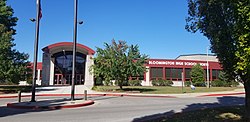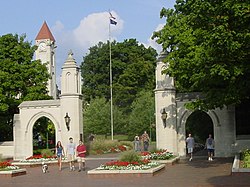Bloomington, Indiana | |
|---|---|
Downtown Bloomington | |
 Location of Bloomington in Monroe County, Indiana | |
| Coordinates: 39°10′0″N86°32′5″W / 39.16667°N 86.53472°W | |
| Country | |
| State | |
| County | Monroe |
| Townships | Bloomington, Perry, Richland, Van Buren |
| Founded | 1818 |
| Incorporated | 1827 |
| Government | |
| • Type | Mayor–council government |
| • Mayor | Kerry Thomson (D) |
| Area | |
| 23.43 sq mi (60.69 km2) | |
| • Land | 23.25 sq mi (60.22 km2) |
| • Water | 0.19 sq mi (0.48 km2) |
| Elevation | 804 ft (245 m) |
| Population (2020) | |
| 79,168 | |
| • Density | 3,405.1/sq mi (1,314.72/km2) |
| • Metro | 175,506 |
| Time zone | UTC−5 (EST) |
| • Summer (DST) | UTC−4 (EDT) |
| ZIP Codes | 47401–47408 |
| Area code | 812 & 930 |
| FIPS code | 18-05860 |
| GNIS ID | 2394196 [2] |
| Website | www |
Bloomington is a city in Monroe County, Indiana, United States, and its county seat. [3] The population was 79,168 at the 2020 census. [4] It is the seventh-most populous city in Indiana and the fourth-most populous outside the Indianapolis metropolitan area. It is the home of Indiana University Bloomington, the flagship campus of the Indiana University system. Established in 1820, IU Bloomington enrolls over 45,000 students. [5]
Contents
- History
- Geography
- Water
- Climate
- Demographics
- 2020 census
- 2010 census
- 2000 census
- Government
- Economy
- Education
- Primary and secondary
- Higher education
- Library
- Media
- Newspapers
- Magazines
- Television
- Radio stations
- Transportation
- Airports
- Bicycling
- Highways
- Public transportation
- Notable people
- In popular culture
- Points of interest
- Sister cities
- See also
- References
- External links
The city was established in 1818 by a group of settlers from Kentucky, Tennessee, the Carolinas, and Virginia who were so impressed with "a haven of blooms" that they called it Bloomington. [6] It is the principal city of the Bloomington metropolitan area in south-central Indiana, which had 161,039 residents in 2020. Bloomington has been designated a Tree City USA since 1984. [7] [8] The city was also the location of the Academy Award–winning 1979 movie Breaking Away , featuring a reenactment of Indiana University's annual Little 500 bicycle race.
















